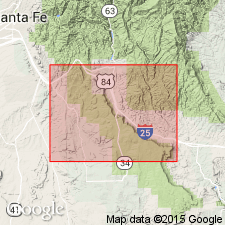
- Usage in publication:
-
- Santa Rosa
- Modifications:
-
- Areal extent
- Dominant lithology:
-
- Sandstone
- AAPG geologic province:
-
- Palo Duro basin
Summary:
Corr. table. Santa Rosa sandstone in Las Vegas area and to east, [Guadalupe County, northeastern New Mexico], is 500 to 600 feet thick. Lies below 800 feet of Triassic red and white beds, and lies above San Andres limestone. [Age is Late(?) Triassic.]
Source: US geologic names lexicon (USGS Bull. 896, p. 1925-1926).
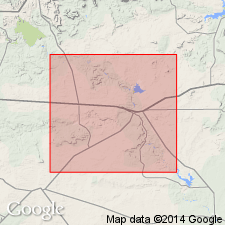
- Usage in publication:
-
- Santa Rosa sandstone
- Modifications:
-
- Areal extent
- AAPG geologic province:
-
- Palo Duro basin
Summary:
Pg. 295-298. Santa Rosa sandstone. Coarse gray sandstone, conglomeratic at base. Thickness 50 to 100 feet. [Recognized in Guadalupe County, northeastern New Mexico.] Is a very definite unit exposed at Santa Rosa and Puerto de Luna and along canyon of Pecos for many miles both above and below those places. From Santa Rosa it can be traced up valley of Pecos as a continuous unbroken escarpment to Estaritos Dome, east of Anton Chico, where it forms the rim rock surrounding the dome. In center of dome, 200+/- feet below base of Santa Rosa sandstone, the San Andreas limestone, 10 to 25 feet thick, is exposed. Beneath the San Andreas on the dome is the Permian Glorieta sandstone. The Santa Rosa sandstone is Upper Triassic.
Source: US geologic names lexicon (USGS Bull. 896, p. 1925-1926).
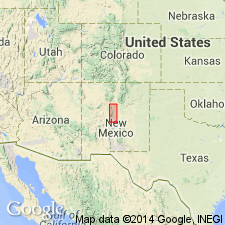
- Usage in publication:
-
- Santa Rosa sandstone*
- Modifications:
-
- Adopted
- AAPG geologic province:
-
- Palo Duro basin
Summary:
Pg. 183 (Mar. 31, 1922). [Santa Rosa sandstone of Dockum group. The name Santa Rosa sandstone was adopted by the USGS, for Mr. Darton's report, in July 1919, but the report was not published until March 1922.] East of Glorieta Mesa and Hills of Pedernal the strata overlying Chupadera formation consist of 800 feet or more of red shales and sandstones representing Dockum group, including near bottom a resistant massive sandstone which is prominent in mesas of Guadalupe County and along Pecos River at Santa Rosa. This sandstone appears to occur at about horizon of Shinarump conglomerate, but no definite correlation is possible, and I here propose for it, tentatively at least, the name Santa Rita sandstone. Case has found in it and above it Triassic bones. It rests on shale that may be either Triassic or Permian. [Age is Late(?) Triassic.]
[Recognized in Guadalupe Co., northeastern NM.]
Source: US geologic names lexicon (USGS Bull. 896, p. 1925-1926).
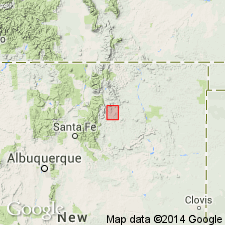
- Usage in publication:
-
- Santa Rosa sandstone*
- Modifications:
-
- Revised
- AAPG geologic province:
-
- Las Vegas-Raton basin
Summary:
Rests disconformably on Bernal formation (new) which encompasses rocks formerly assigned to the upper clastic member of the San Andres formation. Is 425 ft thick east of Ocate. Consists of five distinct ledges 5-10 ft thick of conglomeratic sandstone, brown-red shale and sandstone. Upper contact with Chinle formation placed at uppermost ledge. The ledges are dominantly quartz and also have feldspar and other detrital minerals. Of Late Triassic age. Lies in Las Vegas-Raton basin. Geologic map. Measured sections.
Source: GNU records (USGS DDS-6; Denver GNULEX).
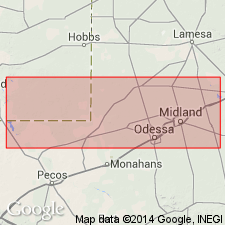
- Usage in publication:
-
- Santa Rosa Sandstone*
- Modifications:
-
- Areal extent
- AAPG geologic province:
-
- Permian basin
Summary:
Shown on a cross section as extending in subsurface from a well in Lea Co, NM to a well in Glassock Co, TX in Permian basin. Overlies Tecovas Formation in east part of area from Winkler to Glassock Cos, TX and Rustler Formation in west part of area from Lea Co, NM to Loving Co, TX. Underlies Chinle Formation equivalent. Of Triassic age.
Source: GNU records (USGS DDS-6; Denver GNULEX).
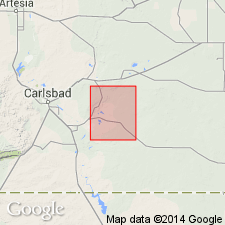
- Usage in publication:
-
- Santa Rosa sandstone*
- Modifications:
-
- Overview
- AAPG geologic province:
-
- Permian basin
Summary:
Only 50 to 70 ft of Santa Rosa present in quad. Unconformably overlies Pierce Canyon redbeds. Unconformably underlies Gatuna formation. Mapped (geologic map) in central and western parts of quad., Eddy Co., NM in the Permian basin. Consists of large-scale trough cross-bedded red sandstone and conglomerate (in lenses 3 to 15 ft thick) separated by partings of red-brown siltstone and silty claystone. The sandstone is poorly sorted, fine- to medium-grained; quartz and chert are the most abundant grains. The conglomerate lenses contain pebbles of silty dolomite and chert or quartz. Plant impressions and fragments, and reptile bones and teeth (phytosaur?) present in some beds. Considered a stream deposit. Assigned as basal formation of Dockum group of Late Triassic age.
Source: GNU records (USGS DDS-6; Denver GNULEX).
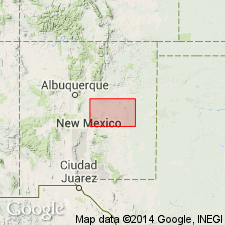
- Usage in publication:
-
- Santa Rosa Sandstone
- Modifications:
-
- Overview
- Dominant lithology:
-
- Sandstone
- Conglomerate
- AAPG geologic province:
-
- Palo Duro basin
- Estancia basin
- Orogrande basin
Summary:
Type locality (has not been previously designated) designated and measured in SW1/4 sec 35, T9N, R21E, 1 mi north of Santa Rosa, Guadalupe Co, NM in the Palo Duro basin. Other measured sections. Is 216 ft thick at type where it consists of a lower part 83 ft thick of white to buff, mostly medium-grained (some beds coarse grained), medium- to thin-bedded sandstone and four beds of brown to buff conglomerate 83 ft thick, and an upper unit of white, coarse-grained, massive sandstone separated from an upper buff to white, medium-bedded sandstone by a gray conglomerate with silicified wood. Pebbles in the conglomerate are of chert, quartz, sandstone, limestone. Contact between the two units is an erosional unconformity. Stratigraphic table. Geologic map; mapped east and west of Pintada Canyon, Guadalupe and Torrance Cos, at Cerro Tecolate, Lincoln Co, along the Pecos River and the Yeso Arroyo, De Baca and Guadalupe Cos, NM, Palo Duro, Orogrande, and Estancia basins. Overlies Yates and Tansill Formations. Underlies Chinle Shale. Triassic age.
Source: GNU records (USGS DDS-6; Denver GNULEX).
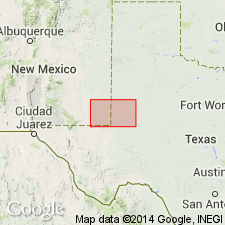
- Usage in publication:
-
- Santa Rosa Sandstone
- Modifications:
-
- Mapped 1:250k
- Dominant lithology:
-
- Sandstone
- Conglomerate
- Clay
- Claystone
- Siltstone
- AAPG geologic province:
-
- Permian basin
Summary:
Pamphlet [p. 4]. Santa Rosa Sandstone [of Dockum Group]. Mostly cross-bedded sandstone, conglomerate, some claystone, and siltstone, pale red to reddish brown. Thickness 50 to 70 feet. Lies below Chinle Formation [of Dockum Group]. Age is Triassic.
[Isolated exposures mapped in Maroon Cliffs area, Eddy Co., NM, and in The Divide area, Lea Co., NM.]
Source: Publication.

- Usage in publication:
-
- Santa Rosa Sandstone
- Modifications:
-
- Overview
- AAPG geologic province:
-
- Permian basin
Summary:
Should not be assigned in the Permian basin to the Dockum [Group or Formation] in the Tucumcari area, NM, and cannot be correlated with the middle member of the Dockum in TX. A benthosuchid skull was found in the basal bed of Santa Rosa in the Tucumcari basin. The same skull has been found in the Holbrook Member of the Moenkopi Formation of AZ. An early Anisian, Middle Triassic age is suggested for the Santa Rosa.
Source: GNU records (USGS DDS-6; Denver GNULEX).
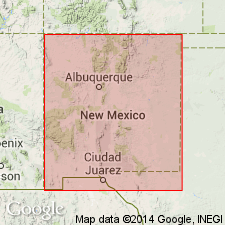
- Usage in publication:
-
- Santa Rosa Formation
- Modifications:
-
- Revised
- AAPG geologic province:
-
- Palo Duro basin
Summary:
Revised to include three new formal members that replace the informal member names used in earlier reports. Tecolotito Member replaces name middle sandstone member; Los Esteros Member replaces name mudstone member; Tres Lagunas Member replaces name upper sandstone member. The lower sandstone member is removed from the Santa Rosa and named Anton Chico Formation. Measured sections of members at their types. Tecolotito is 15.6 m thick; Los Esteros is 9.4 m thick; Tres Lagunas is 7.0 m thick. Nomenclature chart. Underlies lower shale member of Chinle Formation. Of Carnian, Late Triassic age. Correlation chart.
Source: GNU records (USGS DDS-6; Denver GNULEX).
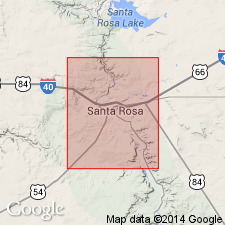
- Usage in publication:
-
- Santa Rosa Formation*
- Modifications:
-
- Biostratigraphic dating
- AAPG geologic province:
-
- Palo Duro basin
Summary:
Six species of plant megafossils described from the mudstone member of the Santa Fe Formation at the principal reference section at N1/2 sec 1, T8N, R21E and SE1/4 SE1/2 sec 36, T9N, R22E and nearby, Guadalupe Co, NM in the Palo Duro basin. Fossils are a fern (CYNEPTERIA LASIOPHORA), cycad (ZAMITES POWELLI), conifer (PELOURDEA POLEOENSIS), lead (DINOPHYTON SPINOSUS), seed (SAMAROPSIS SP), and a pithcast. These same fossils have been found in the Chinle Formation west of the Rio Grande, in other formations of the Dockum Group in TX and NM, and in the Newark Supergroup of the eastern U.S. Flora in the mudstone member are typical of the Carnian Stage, or Upper Triassic.
Source: GNU records (USGS DDS-6; Denver GNULEX).
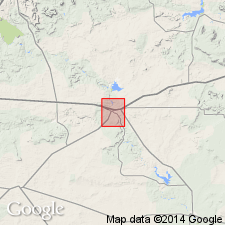
- Usage in publication:
-
- Santa Rosa Formation*
- Modifications:
-
- Principal reference
- Redescribed
- Age modified
- Dominant lithology:
-
- Sandstone
- Mudstone
- Conglomerate
- AAPG geologic province:
-
- Palo Duro basin
Summary:
Redescribed from Santa Rosa Sandstone to Santa Rosa Formation, basal formation of Dockum Group. Crops out in Guadalupe, San Miguel, Quay and DeBaca Cos, NM and Oldham Co, TX, Palo Duro basin. Identification east of Tucumcari, NM and in TX controversial. Outcrops scattered. Principal reference section designated because mudstone member not present at type along railroad cuts adjacent to El Rito Creek and on slopes north of westernmost lake of Tres Lagunas, N1/2 sec 1, T8N, R21E and SE1/4 SE1/2 sec 36, T9N, R22E, Guadalupe Co. Overlies Queen Formation of Artesia Group; underlies Chinle Formation of Dockum at principal reference section where formation is 228 ft thick and divisible into lower and middle sandstone members, mudstone and upper sandstone members. Composed of pale red to yellow-brown, very fine, fine, medium- to coarse-grained, brown to brown weathering sandstone with interstitial white, clay, brown siltstone, gray-red, calcareous siltstone, and scattered quartz-chert-limestone pebble and limestone granule beds. Some beds ripple marked, some cross-bedded. All are calcareous. Fossil wood. Age changed from Late Triassic to Middle and Late Triassic. Anisian amphibian skull in lower sandstone member. Carnian plant fossils in mudstone member.
Source: GNU records (USGS DDS-6; Denver GNULEX).
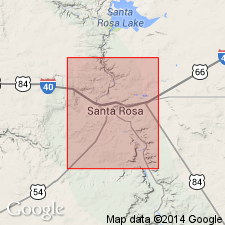
- Usage in publication:
-
- Santa Rosa Formation*
- Modifications:
-
- Areal extent
- AAPG geologic province:
-
- Palo Duro basin
Summary:
Consists of continental sediments at principal reference section in N1/2 sec 1, T8N, R21E and SE1/4 SE1/2 sec 36, T9N, R22E, Guadalupe Co, NM in the Palo Duro basin. The three sandstone members--lower, middle, and upper were deposited as alluvial sheets by braided streams. The mudstone member was deposited under lacustrine condition-mainly lakes developed by local subsidence caused by dissolution of Permian salt. Each member has different paleotransport trends. Lower member was dominantly north, middle member was south, mudstone member direction not conclusive, and upper member was to northeast. Triassic.
Source: GNU records (USGS DDS-6; Denver GNULEX).
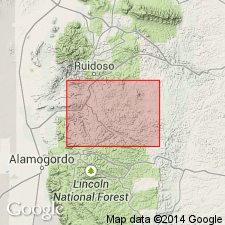
- Usage in publication:
-
- Santa Rosa Sandstone*
- Modifications:
-
- Areal extent
- AAPG geologic province:
-
- Orogrande basin
Summary:
Mapped in Otero Co, NM in the southeastern part of the Orogrande basin. Present in northwest part of study area. Contacts concealed at most places by alluvium and colluvium. Unconformable contact with Permian San Andres Limestone seen in roadcuts. Next younger unit in this quad is the Cretaceous Sarten Sandstone. Is 0 to 250 ft thick. Assigned a Late Triassic age.
Source: GNU records (USGS DDS-6; Denver GNULEX).
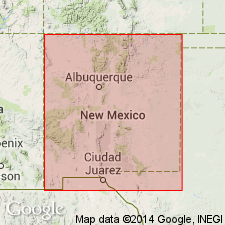
- Usage in publication:
-
- Santa Rosa Formation
- Modifications:
-
- Contact revised
- AAPG geologic province:
-
- Palo Duro basin
- Estancia basin
Summary:
Basal contact revised in that Tecolotito Member of Santa Rosa Formation disconformably overlies Anton Chico Member (new rank) of Moenkopi Formation. Upper contact revised in that Santa Rosa Formation conformably underlies the newly named Garita Creek Formation, a new name that replaces the lower shale member of the Chinle Formation in east-central NM in the Palo Duro basin. Chinle no longer used by these authors in east-central NM. Santa Rosa recognized as far west as T14N, R10E near Lamy, Santa Fe Co, NM in the Estancia basin. Stratigraphic table. Divisible into (ascending) Tecolotito, Los Esteros, and Tres Lagunas Members. The vertebrate fauna--METOPOSAURUS sp., DESMATOSUCHUS sp., CALYPTOSUCHUS, POSTSUCHUS KIRKPATRIKI, (and a new sphenosuchian)--found in the Los Esteros Member represent the oldest Late Triassic assemblage of fossil vertebrates in North America. Assigned to the Late Triassic (Carnian and Norian).
Source: GNU records (USGS DDS-6; Denver GNULEX).
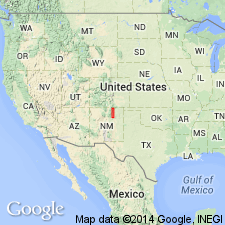
- Usage in publication:
-
- Santa Rosa Formation
- Modifications:
-
- Areal extent
- AAPG geologic province:
-
- Las Vegas-Raton basin
- Palo Duro basin
Summary:
The three members of the Santa Rosa Formation--the basal Tecolotito; middle or Los Esteros; and the upper, Tres Lagunas--can be recognized as far north as La Cueva, Mora Co, NM, Las Vegas-Raton basin. North of La Cueva, only the Tecolotito Member is thought to be present, and the Los Esteros and Tres Lagunas have pinched out. Correlation chart. Cross section. Identified in measured sections at Montezuma Gap and San Sebastian, San Miguel Co, Palo Duro basin, at La Cueva, Mora Co, and at Rayado, Uracca, and Ricardo Creeks, Colfax Co, Las Vegas-Raton basin. Many previous workers have used Santa Rosa Sandstone in report area; few place the lower and upper contacts at the same horizon. Of Late Triassic, Carnian age.
Source: GNU records (USGS DDS-6; Denver GNULEX).
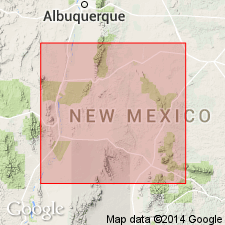
- Usage in publication:
-
- Santa Rosa Formation
- Modifications:
-
- Areal extent
- Revised
- AAPG geologic province:
-
- Orogrande basin
Summary:
Two names, the Santa Rosa and Shinarump Formations, the lower formations of the Chinle Group, have been applied to the silica pebble conglomerate and siltstone interval in central NM that lies disconformably on the Moenkopi Formation. The upper contact of both formations is revised in that they underlie the newly named San Pedro Arroyo Formation of the Chinle Group. The study area lies between the Colorado Plateau where the name Shinarump Formation (rank term used by this author) and east-central NM where the name Santa Rosa Formation has been used. Author recognizes that either name could be chosen. He prefers to use Shinarump along the Colorado Plateau edge in Valencia Co. in the San Juan basin and along the east edge of the Rio Grande rift near Carthage in Socorro Co., Orogrande basin. The Shinarump in these areas is thin (less than 6 m), discontinuous, trough cross-bedded silica pebble conglomerate. Eastward in Lincoln Co. in the Orogrande basin where the name Santa Rosa is preferred, the interval is thicker (13-26 m), more persistent, has silica pebble conglomerates and non-conglomeratic sandstones. Santa Rosa in Lincoln Co. is a yellow and brown, silica pebble conglomerate and micaceous subarkose; the lithology resembles the Tecolotito Member of the Santa Rosa to the north. Cross sections. Stratigraphic charts. Of Carnian, Late Triassic age.
Source: GNU records (USGS DDS-6; Denver GNULEX).
For more information, please contact Nancy Stamm, Geologic Names Committee Secretary.
Asterisk (*) indicates published by U.S. Geological Survey authors.
"No current usage" (†) implies that a name has been abandoned or has fallen into disuse. Former usage and, if known, replacement name given in parentheses ( ).
Slash (/) indicates name conflicts with nomenclatural guidelines (CSN, 1933; ACSN, 1961, 1970; NACSN, 1983, 2005, 2021). May be explained within brackets ([ ]).

